Gear Reviews
Review – DSM Noisemaker Drive Maker Pedal
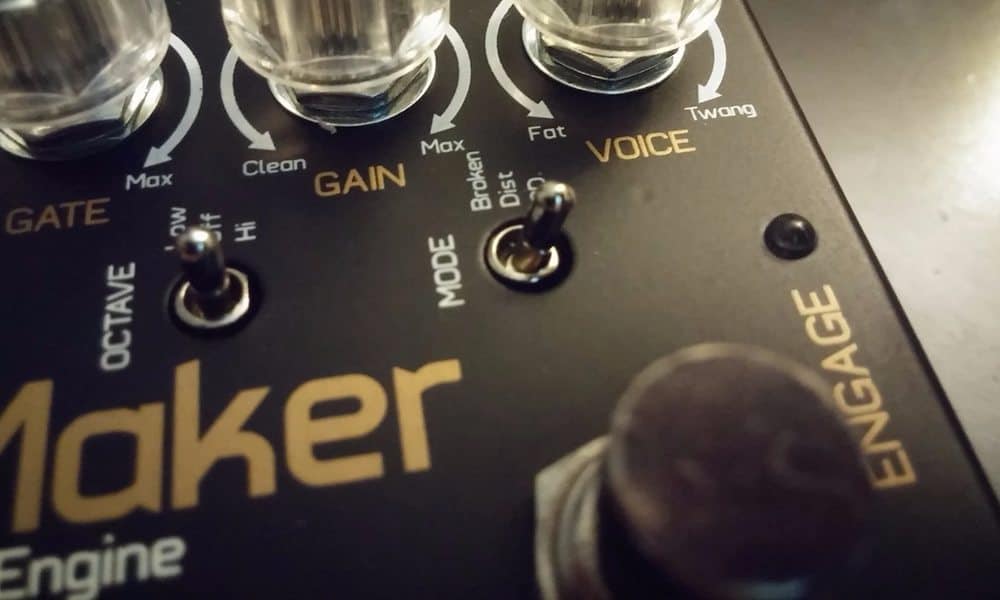
It may be hard to imagine Chile as a nexus of effect pedal innovation, but Chile’s DSM Noisemaker has quickly made a name for themselves with the success of their cabinet simulator pedal, the Omni Cab Sim Deluxe (OCSD).
On the heels of BMM’s review of the OCSD, I thought I’d take a moment to review DSM’s other super cool and unique offering, the Drive Maker. In the fashion of their Omni Cab Sim, the Drive Maker packs a ton of features into a very well designed and superbly constructed pedal. The Drive Maker dishes out a wide set of features, not immediately apparent when looking at its small footprint and compact controls. Full disclosure: I’m not exactly a guru of drive. I typically opt for the various colors of clean and transparent in my tone, but I know a drive/fuzz is good when I can’t stop playing with it, which is the case with the DSM. I easily dialed up a wide array of awesome sounds, from searing lead fuzz to rumbly deep grit, and even some funky, non-linear breakup that was reminiscent of a dirty ring modulator. Muy bueno. It didn’t take long to realize that DSM is forging a path with this pedal, and not copying or replicating other popular designs. According to the manual, “the core of the Drive Maker engine is the “NAFTA” engine (“Not Another Friggin TubeScreamer Again”)”, which gives one a pretty clear sense of where DSM stands in regards to bringing something unique to a crowded market. Daniel Schwartz Muñoz (DSM) says: “The drive maker was born after years of research for the perfect distortion. There´s no perfect distortion! as every tone has its time and place on music. It had to be the most versatile analog drive available, and have its own thing going on at the same time. It was a painstaking design”.

One would be hard pressed to imagine getting more features into a pedal of this size. The front panel is jam packed with switches and knobs, and although this can make it a little tough to read at times, you really have to hand it to the designers for managing to cram so many cool features into a pedal roughly the size of a bar of soap. Not only does the Noise Maker deliver overdrive and distortion tones, EQ, a noise gate, and a selectable mid boost, it also contains a ¼” fx loop that allows you to plug other pedals into the Noise Maker, so that when you kick on the boost channel for extra gain, you can add with it some additional effects of your liking. This makes for a pretty nifty solo/lead channel where the sound of several pedals can be accessed with one stomp. Inside the chassis, you can select via dip switches whether the fx loop is on all the time, or only when the boost channel is engaged, further adding to the Drive Makers high degree of flexibility and customized control.
Looking at the top row of knobs, the Drive Maker has just the kind of controls I would want on a drive pedal. The sensible Voice knob functions as a global EQ, going from a bass boost at minimum, all the way to a treble boost at maximum. At noon, it is fairly balanced, EQ-wise. The Gain knob offers a somewhat clean boost all the way up to a full-on saturated drive as you approach the upper limits. The addition of the Gate knob is really cool, in my opinion. It works great for higher saturation tones, and really helps to tame the beast, so to speak. I liked adding in just a little of the gate at lower settings as well for a slightly smoother sound. The Bass and Treble knobs (+/- 10dB) are of course super helpful for dialing in a balanced bass tone to suit an individual’s preferences. Finally, an overall Level control serves as a master volume, for optimal control over gain staging. Moving to the switches, The DM has three main distortion modes; a lower gain creamier OD that offered a variety of soft clipping overdrive sounds. I was able to cop some Motown-y vibes in this mode, and at higher gain settings, a full-on distortion. The higher gain Dist mode serves up considerably hotter, more saturated sounds. Be careful switching from one to the other, as there’s a sizable volume jump. The Broken mode is the most mysterious and unique mode. I think the best description is DSM’s own, from the manual: “Very asymmetric, weird drive. At mid gain, it is very bluesy and full of harmonics. At high gain, with powerful pickups, it “chokes” and sounds fuzzy and weird. Very unique”. It sounded similar to my ears to the Dist mode, but with more artifact and odd breakup characteristics that were a little unpredictable, but lots of fun to get weird with. In addition, the Drive maker offers three different Octave modes; Low, Normal, and High. The High octave brings in a ton of upper harmonic content and in is the most interactive with the higher gain drive modes. It definitely was the most fun as a soloing/lead tone and had a dynamic response that was very expressive. In the Normal position there is no octave effect, and Low adding a little less of the upper octave sound with a slightly different midrange characteristic. The Mid switch (phew!) offers a 700hz scoop, an 800hz-2Khz boost and a flat response, further allowing you tailor the drive engines overall voicing.
The Boost switch offers even more (getting tired yet?) configurable awesomeness to the already long list of the Drive Maker’s features. Not only do you get up to 30dB of continually variable boost via the tiny black thumbwheel, but as mentioned earlier, with internal switches settings, you choose whether the unit’s FX loop is on full-time when the pedal is engaged, or only when in boost mode. I think that makes for a pretty awesome solo channel, giving your sound a boost and simultaneously controlling a number of effect pedals all at once, for simplicity on stage.
Whew! That’s a whole lot of pedal. The takeaway for me with the Drive Maker, as well as DSM’s Omni Cab Sim Deluxe is that both pedals seem to be designed for maximum control over a large number of parameters. As opposed to being designed around specific overdrive or distortion standards, the Drive Maker delivers a powerful drive “engine” and a whole lot of ways in which It can be manipulated to create unique and inspiring overdriven sounds. Whereas this approach can sometimes result in overly complicated designs that are hard to get dialed in properly, the Drive Maker is intuitive and easy to set up. The addition of the bass and treble control, as well as the global voice control means that almost any mode or octave setting can be made usable, which makes for a heck of a lot of variety. The gate control is another standout feature of this pedal. As someone who doesn’t often go for highly saturated overdriven sounds, it allowed me to tame the distortion characteristic, without changing the degree of gain or output volume.
All in all, I have to hand it to Daniel at DSM for crafting a well-made, highly tweakable, intelligently designed pedal, capable of producing a wide array of inspiring and usable drive flavors. Bass players should definitely consider the Drive Maker when looking for an overdrive pedal for their rig, especially those who like to tweak and adjust to their hearts content. Considering its unique feature set and the signature tones its capable of serving up, I would definitely recommend this pedal to all my distortion loving buddies. Play guitar too? Flip the other dip switch inside to change the tone profile and you’ve got all the Drive Maker’s deluxe features, tonally optimized for a guitar’s frequency range. That’s quite the two-fer. The Drive Maker sells direct from DSM for $239 plus shipping. For more info and video samples, visit DSM Noisemakers website.
Bass Videos
String Instrument Humidifiers
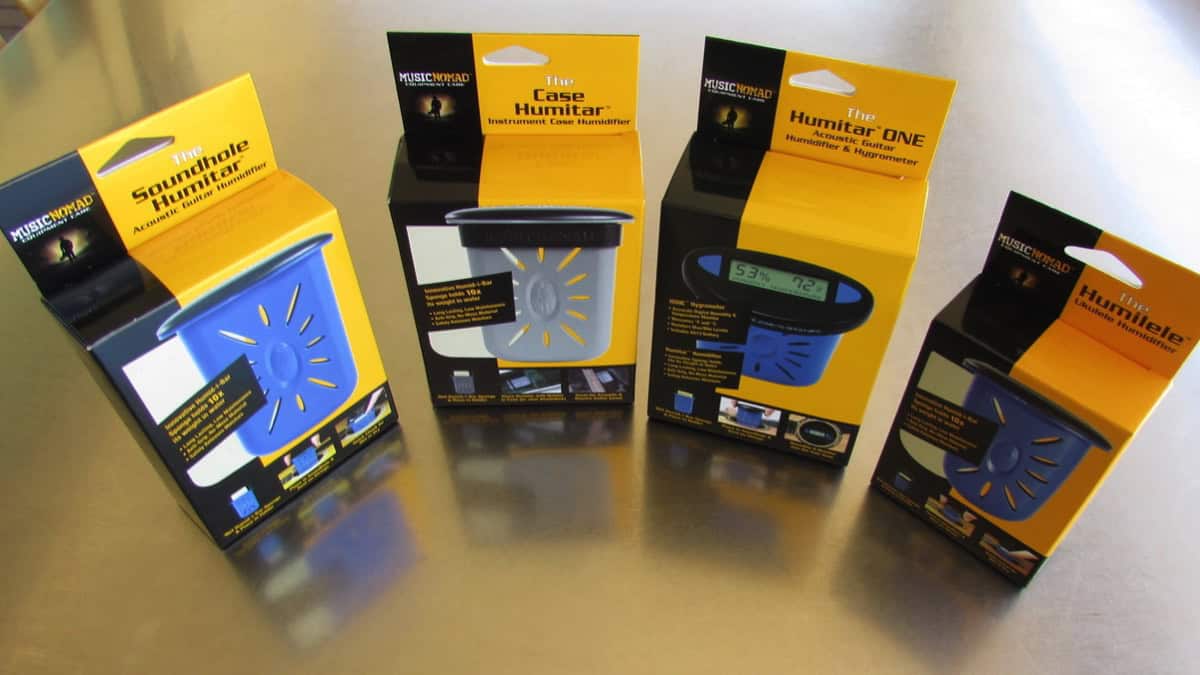
String Instrument Humidifiers
After living in some very humid parts of the country for decades, we moved to a dryer, much sunnier location. As a result, I started noticing some fret sprout on my string instruments and recently did a video on fret sprout correction.
It occurred to me that I should take a more preventative approach to string instrument humidification. Of course, I turned to my instrument maintenance experts, Music Nomad Equipment Care, for a solution and they suggested their Humitar series. (Note: They sent two press samples and I purchased the remainder online.)
Join me as I look at these useful tools for keeping my string instruments in tip-top condition.
The Humitar series is available online at Music Nomad Equipment Care, as well as Amazon.com
Bass Videos
Review: CrystalBright Rombo Picks
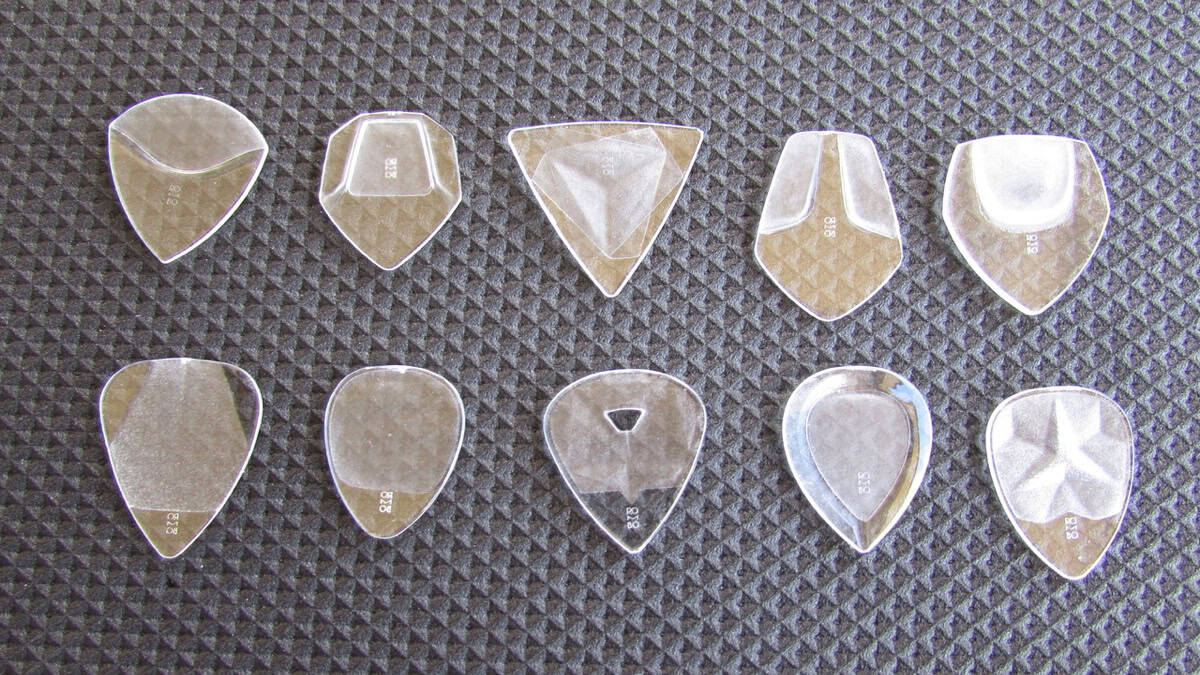
CrystalBright Rombo Picks
PR SamplePlaying bass with a pick is still a touchy subject in our community. I believe you should be able to use whatever you need to get your sound. Even though I mostly play with my fingers, I like to check out innovative new picks that might have something new to offer, sonically speaking.
Judith and Carlos from Rombo recently contacted me about a new material called CrystalBright that they have been researching for the last 12 months and offered to send some prototype picks. After trying them out, I put together this video with my findings.
For more info check out @rombopicks
Gear
New Joe Dart Bass From Sterling By Music Man

Sterling by Music Man introduces the Joe Dart Artist Series Bass (“Joe Dart”), named after and designed in collaboration with the celebrated Vulfpeck bassist.
Above photo credit: JORDAN THIBEAUX
This highly-anticipated model marks the debut of the Dart bass in the Sterling by Music Man lineup, paying homage to the Ernie Ball Music Man original that all funk players know and love. The bass embodies many of the original model’s distinctive features, from its iconic minimalist design to the passive electronics.

The design process prioritized reliability, playability, and accessibility at the forefront. Constructed from the timeless Sterling body, the Dart features a slightly smaller neck profile, offering a clean tone within a comfortable package. The body is crafted from soft maple wood for clarity and warmth while the natural finish emphasizes the simple yet unique look.
Engineered for straightforward performance, this passive bass features a ceramic humbucking bridge pickup and a single ‘toaster’ knob for volume control. Reliable with a classic tone, it’s perfect for playing in the pocket. The Dart is strung with the all-new Ernie Ball Stainless Steel Flatwound Electric Bass Strings for the smoothest feel and a mellow sound.

The Sterling by Music Man Joe Dart Bass is a special “Timed Edition” release, exclusively available for order on the Sterling by Music Man website for just one month. Each bass is made to order, with the window closing on May 31st and shipping starting in November. A dedicated countdown timer will indicate the remaining time for purchase on the product page. Additionally, the back of the headstock will be marked with a “2024 Crop” stamp to commemorate the harvest year for this special, one-of-a-kind release.
The Joe Dart Bass is priced at $399.99 (MAP) and can be ordered globally at https://sterlingbymusicman.com/products/joe-dart.
To learn more about Joe Dart, visit the official Vulfpeck artist site here https://www.vulfpeck.com/.
Gear Reviews
The Frank Brocklehurst 6-String Fretless Bass Build
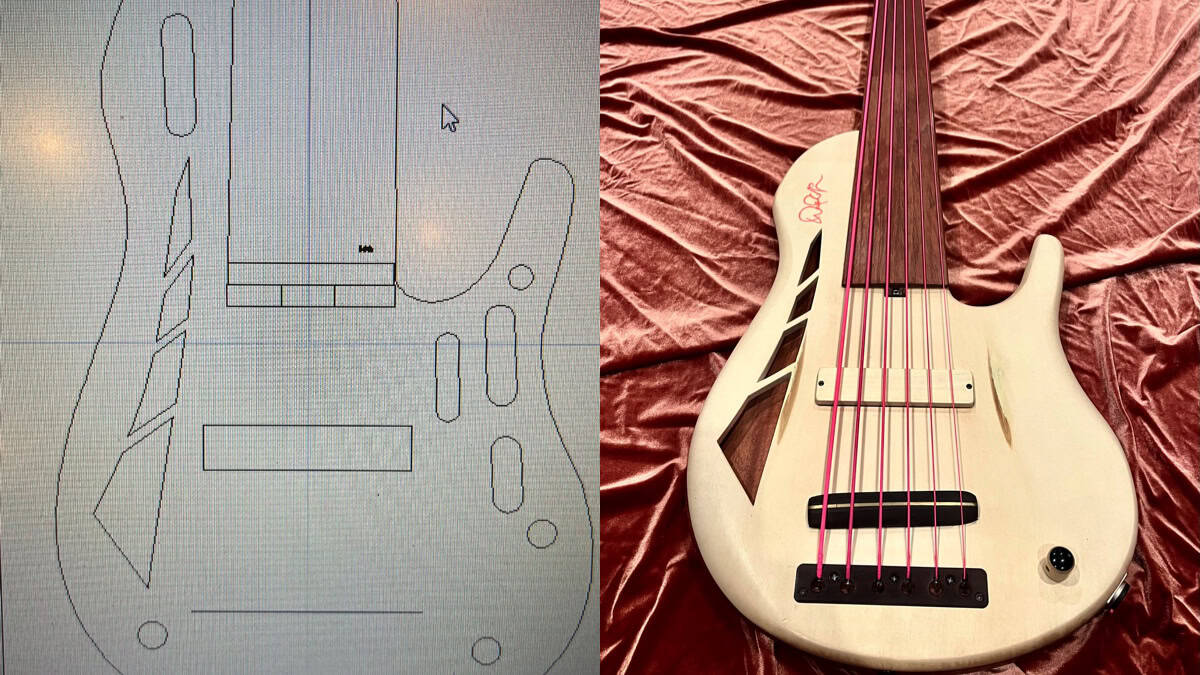
A few months ago, my Ken Bebensee 6-string fretted bass needed some TLC. You know, the one rocking those Pink Neon strings! I scoured my Connecticut neighborhood for a top-notch luthier and got pointed to Frank Brocklehurst, F Brock Music. He swung by my place, scooped up the bass, and boom, returned it the next day, good as new. Not only that, he showed up with a custom 5-string fretted bass that blew me away. I couldn’t resist asking if he could whip up a 6-string fretless for me.
Alright, let’s break down the process here. We’ve got our raw materials: Mahogany, Maple, and Holly. Fun fact – the Mahogany and Maple have been chilling in the wood vault for a solid 13 years. Frank is serious about his wood; they buy it, stash it away, and keep an eye on it to make sure it’s stable.

First up, they’re tackling the Mahogany. Frank glues it together, then lets it sit for a few days to let everything settle and the glue to fully dry. After that, it’s onto the thickness planer and sander to get it nice and flat for the CNC machine. The CNC machine’s the real star here – it’s gonna carve out the body chambers and volume control cavity like a pro.

While the Mahogany’s doing its thing, Frank goes onto the neck core. Three pieces of quartersawn maple are coming together for this bad boy. Quartersawn means the grain’s going vertical. He is also sneaking in some graphite rods under the fingerboard for stability and to avoid any dead spots. The truss rod is going to be two-way adjustable, and the CNC machine’s doing its magic to make sure everything’s just right.

Now, onto the design phase. Frank uses CAD software to plan out the body shape, neck pocket, chambering, and those cool f-holes. I had this idea for trapezoid F-holes, just to do something different. The CAD software also helps us map out the neck shape, graphite channels, and truss-rod channel with pinpoint accuracy.

Once everything’s planned out, it’s CNC time again. Frank cuts out the body outline, neck pocket, and the trapezoid F-holes. Then it’s a mix of hand sanding and power tools to get that neck just how we like it. Oh, and those f holes? We’re going for trapezoids of different sizes – gotta keep things interesting.

Next step: gluing that neck into the pocket with some old-school hide glue. It’s got great tonal transfer and can be taken apart later if needed. Then it’s onto hand-carving that neck-body transition.

For the custom-made bridge, Frank uses brass for definition and Ebony for tonal transfer and that warm, woody sound.

BTW, for tunes, Frank went with Hipshot Ultralights with a D Tuner on the low B. This way I can drop to a low A which is a wonderful tone particularly if you are doing any demolition around your house!
Now it’s time for the side dots. Typically, on most basses, these dots sit right in the middle of the frets. But with this bass, they’re placed around the 1st, 3rd, 5th, 7th, 9th, and 12th frets.

Frank’s got his pickup hookup. Since the pickup he was building wasn’t ready, he popped in a Nordstrand blade to give it a whirl.

It sounded good, but I was itching for that single-coil vibe! And speaking of pickups, Frank showed me the Holly cover he was cutting to match, along with all the pink wire – talk about attention to detail!

A couple of things, while it is important for me to go passive, it is equally important for me to just go with a volume knob. Tone knobs are really just low-pass filters and the less in the way of a pure sound for me, the better.
Finally, it’s string time! As usual, I went for the DR Pink Neon strings. Hey, I even have matching pink Cons…Both low tops and high!

Once we’ve got everything tuned up and settled, we’ll give it a day or two and then tweak that truss rod as needed. And voila, we’ve got ourselves a custom-made bass ready to rock and roll.

I want to thank Frank Brocklehurst for creating this 6 string beast for me.
Gear Reviews
Review Transcript: BITE Custom Bass – The Black Knight PP Bass
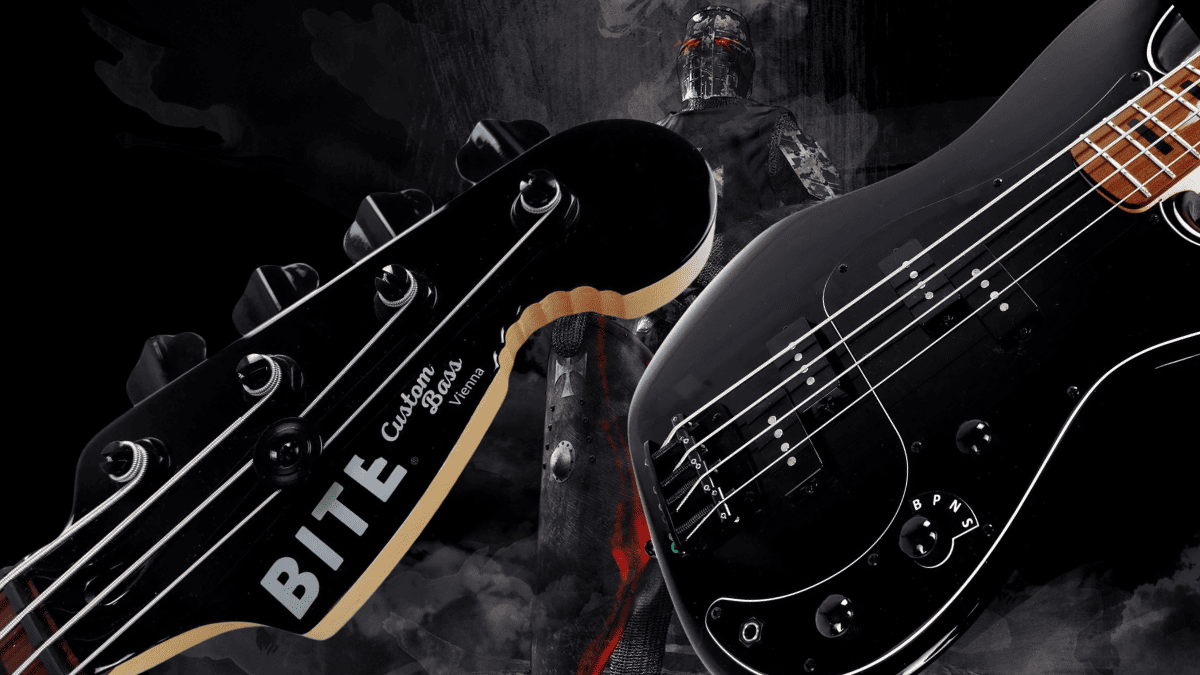
This is a written transcript of our video review of the BITE Custom Bass Black Knight PP Bass originally published on March 4, 2024
BITE Custom Bass – The Black Knight PP Bass Review…
Bass Musician Magazine did a review on a Steampunk bass from BITE Guitars about three years ago, it was an amazing instrument, and we were very impressed. Now we’re happy to bring you another BITE bass, the Black Knight PP.

Everybody needs a P-type bass, it’s the standard of bass. If you’re recording, they want you to have a P bass. So why not have something that gives you a little more by having two instead of one P pickup. That’s the idea of this bass, it’s the first thing that leaps out: the double P pickup configuration.

Installing two of their 1000 millivolt split-coil pickups, BITE then went one step further and wired them up in a 4-way parallel/series circuit, a look at the controls reveal a 4-way rotary selector:
The first position, marked “B”, gives you the bridge pickup by itself.
The second position, marked “P”, gives you the bridge and neck pickups in parallel mode, that’s the traditional J-type circuit, it reduces output due to the physical law of parallel circuits.
Position number 3 is marked “N”, it gives you the neck pickup by itself.
And finally, number 4, marked “S”, gives your bridge and neck in a series (humbucking) mode which adds up resistances and thus boosts output. The other two controls are master volume and master tone.

What’s more, like every BITE bass, this one also has a reinforced headstock heel designed to give it extra output and sustain. The BITE website features a graph and explanation of what they have done to the heel, as compared to traditional headstocks.

A look at the body reveals a beautiful Black Blast body finish and underneath that we have alder wood. The bass has a matching headstock with a 4-in-line tuner setup and the traditional bite out of it, so everybody will know what kind of bass you’re playing. The pickguard is 3-ply black, the neck is vintage tinted hard maple and it has a satin speed finish at the back which keeps your thumb from sticking.
On top of that, there’s a clear-coated roasted black locust fretboard with black blocks marking the frets. The nut is a black Graph Tec nut, we’ve got diamond dome control knobs, and the tuners are lightweight compacts with cloverleaf buttons and a 1:17 ratio precision gear. The bridge is a Gotoh brass bridge with 19-millimeter string spacing.
Overall measurements: we’ve got a standard 34″ scale, a 1.65″ width nut and a C neck profile. This bass weighs 8.2 pounds, or 3,7 kilograms for our metric friends, and it uses standard 18% nickel silver frets.
Taking a closer look at the sound, this bass is a joy to play. The BITE proprietary 1000 millivolt pickups deliver an extraordinary amount of output which is surprising considering this is a passive instrument. You may even want to set your amp to active mode because of all of the juice you’re getting out of this guy.
The tonal possibilities are very versatile, it’s a straight P if you want but also much more with those different arrangements of the circuitry. So why have multiple basses when you’ve got one that can give you your basic P plus a lot more?
To sum it up, the Black Knight PP is an amazing instrument. The attention to detail that BITE puts into their basses is second to none. This bass is also amazingly balanced and gorgeous to hold and feel with the satin neck finish.
For more information, visit online at bite.guitars/product/black-knight-pp








